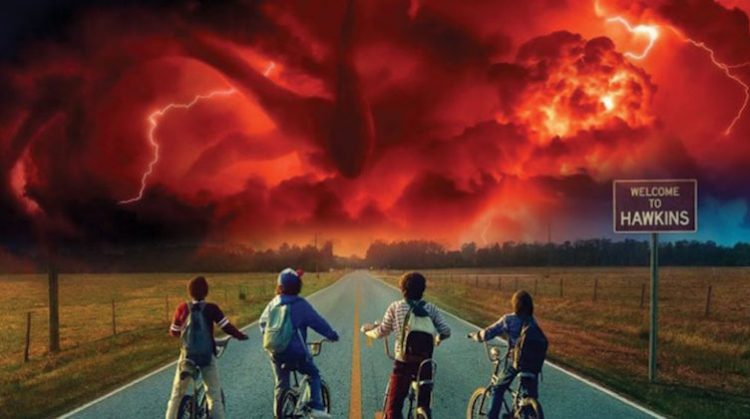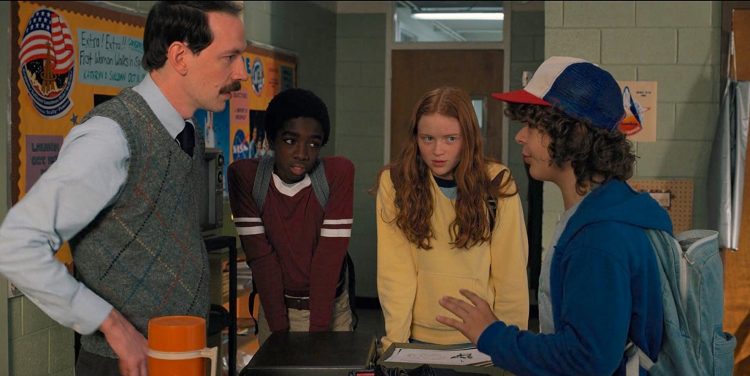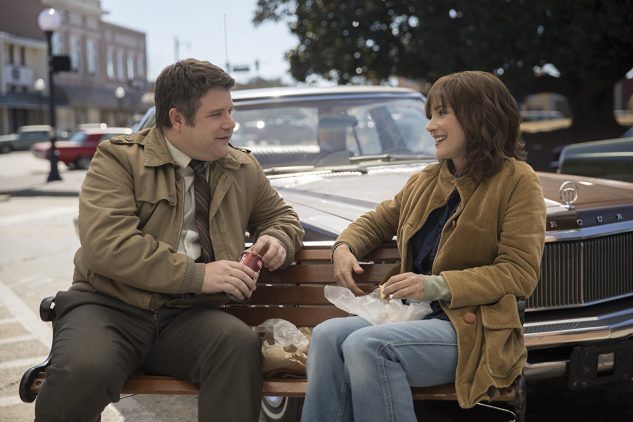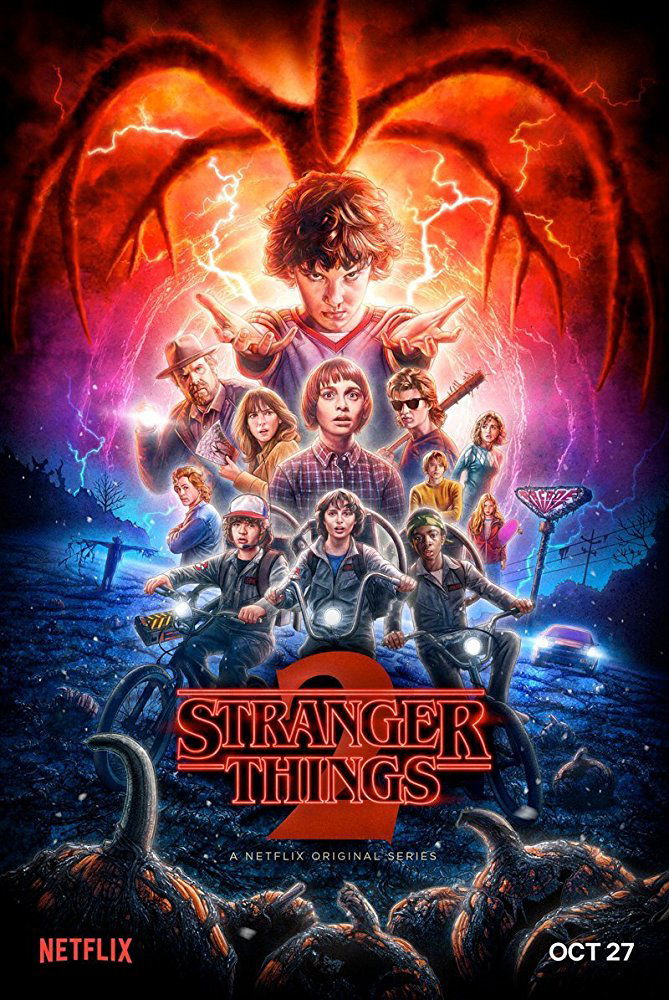When Stranger Things came out last year, it seemingly became a hit out of nowhere. How could a show that’s one big homage to 1980s cinema have such an impact on modern day pop culture? Unsurprisingly, nostalgia is a powerful thing. Yet the show rose above simply paying respect to the era in creating a successful story of its own. Sure, it borrowed from the likes of The Goonies, Stand by Me, E.T. and other classic films. Yet it didn’t merely throw these elements into a pot and leave it to simmer. It synthesized everything that influenced it to become its own thing. But when the Duffer Brothers announced season two, the big question was: could they do it again? The answer: a wholehearted yes. Season two is not only just as good as the first season, in some ways it’s better.
Returning to the town of Hawkins, Indiana, things are pretty much just as they were left at the end of the first season. In short, it’s a bit of a mess. But it’s being cleaned up. Will is back, safe and sound with his family. However, he’s not out of the clear just yet, plagued by lingering visions of the Upside Down. This time, the parallel universe contains a large, tentacled monster that seems to be made of smoke. Joyce, his mom, takes him to Hawkins lab to get Will’s “hallucinations” checked out. Yes, that Hawkins Lab. Except it’s now run by Dr. Owens, who seems to want to fix the mistakes of the previous occupants. Meanwhile, Chief Hopper has Eleven hidden away in a cabin, where he provides her with Eggos, of course.
Surprisingly, there’s very little conflict for much of the second season. The stakes are much lower, and the story is more concerned with tying up the loose ends from season one and showing how the characters are processing the events they just witnessed. This may bother some people, especially since the trailers seemed to tease that season two would have “bigger conspiracies and bigger monsters.” In actuality, both of these things are smaller. But don’t let that discourage you. A lesser show would confuse bigger for better and up the ante each season until it burnt out, but Stranger Things is not that show. It’s smarter. It knows that expectations shouldn’t come in the way of telling a good story. So while season two is quieter, it’s in many ways more interesting. The new folks at Hawkins Lab really are more concerned with containing the mess of the Upside Down than profiting from it. They’re not the moral compass of the show, but they’re nowhere near as dastardly as their predecessors. And this makes sense. The giant monster from the trailers is not quite as pressing of a threat as the Demogorgon, at least not for a while. But it adds mystery.
However, if you’re afraid that the entire second season is a sort of extension of the first, rest assured that it is very much its own thing. The fact that the characters are aware of their town’s mysteries and have bonded with each other allows the show to make time to expand on the lore of its world. We find out more about Eleven and her history. We learn more about the Upside Down, how it works, and the creatures that live inside it. The season gives time to unresolved issues. Those who crave justice for Barb will be pleased to know that time is spent on getting the news of her death out to her loved ones. The show uses these extra bits of lore and tied up plot threads as a foundation. Characters have more to investigate and find that the past isn’t easy to leave behind. Actions can have far reaching consequences that can grow into problems all their own. The narrative uses the foundation laid to build something that doesn’t eclipse previous events, but extends them into something bigger.
The show has a few new characters. Oddly enough, they comprise the only aspect of the show that feels like it’s trying to one-up itself. Remember Steve, Nancy’s kind-of-a-jerk boyfriend? New kid Billy is an even bigger jerk. Will and his friends immediately consider asking his tough-cookie sister Max to join their troupe as if she’s the new Eleven. While Billy’s antics become grating as it seems he exists solely to make Steve likable, Max proves that she’s not just filling in for when the boys’ psychic friend returns. Sadie Sink makes Max a different sort of aloof than Millie Bobby Brown’s Eleven. Her slow-to-trust nature comes from a place of independence, as her family is hardly around. Unlike Eleven, whose special powers alone make her unique, Max stands out from the world-weary personality that Sadie Sink plays her with.
Paul Reiser is not to be underestimated as Dr. Owens, the new head of Hawkins Lab who could’ve come off as another soulless scientist in less capable hands. He strikes a fine line of showing humanity without ever letting the audience forget that he’s still connected to the same mysterious government crew that unleashed the horrors of the Upside Down in the first place. In every scene he’s in, it’s never quite clear exactly what his motivations are up until the very end. Last but not least, Sean Astin is a pleasant addition as Bob Newby, Joyce’s new boyfriend. He comes off as goofy and a bit hokey, but lovable. His chemistry with Winona Ryder is great, as we get to see Joyce happy for the first time in a while. He feels like an adult version of a character that would belong in Will’s friend group, which allows him to connect with the kids. I wouldn’t be the least bit surprised if he turns out to be this season’s fan-favorite character.
This time around, Stranger Things wholeheartedly embraces its Halloween and autumnal setting. It’s one of those things that you don’t think about while watching, but succeeds because of how unobtrusive it is. It enhances all of the other elements of the show, from the music and the lighting to the setting and the characters. The Halloween release date was a smart move, and plays in with this motif. Pumpkins feature heavily in one of the opening mysteries this time around. The kids’ Halloween costume antics showcase the dialogue that captures their ages and group dynamic so well. This whole vibe injects just a little bit more energy into the horror side of the show as well. It’s nothing revolutionary, but a nice example of how a given theme can enhance various aspects of a work.
The new season of Stranger Things may not have the intensity or urgency of the first season, but it succeeds with flying colors on its own terms. Most of its risks pay off, though some don’t. After all the chaos that rocked the town of Hawkins, it’s good to have a more introspective season. Ultimately, it proves that Stranger Things has what it takes to last for a while as a show, and I’m excited to see where it goes from here.
Verdict
Stranger Things uses its second season to add to the world and characters that it established a year ago. It succeeds by standing on the shoulders of the first season, and solidifies the show as one that has the potential for longevity.







